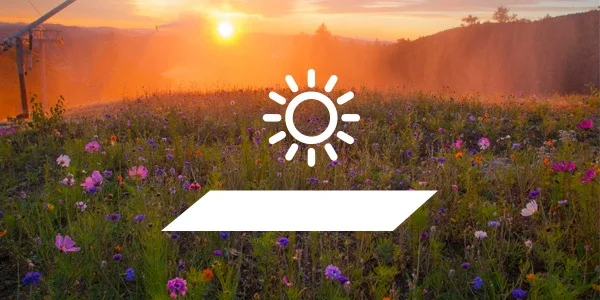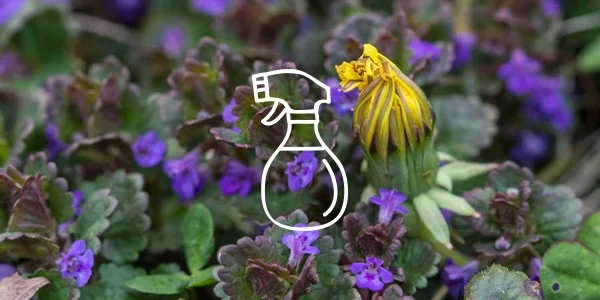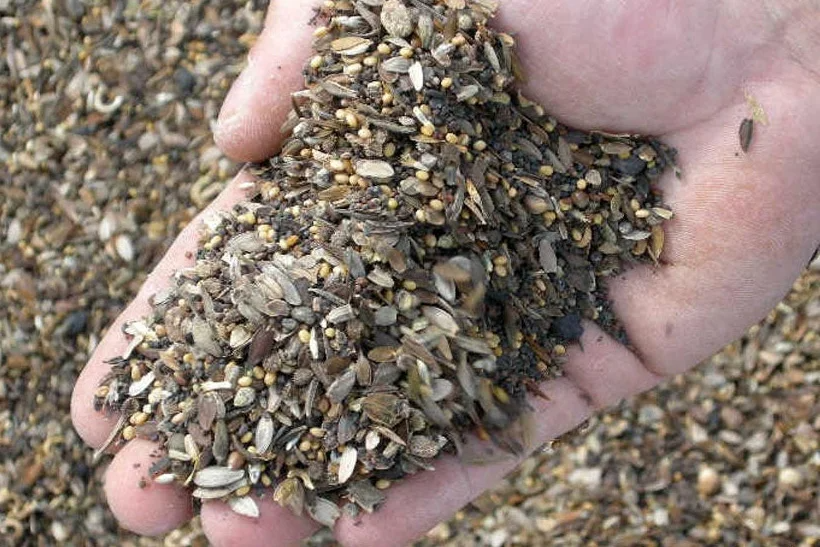Fall is For Planting Wildflowers
1. Identify The Correct Planting Time For Your Area
Fall is a perfect time to sow wildflower seeds. This timing follows the same approach as Mother Nature: wildflowers naturally drop their seeds in fall to take advantage of the freezing, thawing, and/or extra moisture that winter delivers. This weather helps to crack open their hard, outer seed cases.

Fall Planting Wildflower Seed in Colder Climates
Fall seeding is a good choice if you live in an area that experiences cold or freezing winters, and the ground freezes for more than 60 days. Though you have a shorter growing season, you’ll get a jump start on spring growth, and should see color 2-4 weeks earlier than with spring planting.
Before planting in fall, be sure that it’s truly cold enough. The best strategy is to plant after at least one or two killing frosts. See our Frost Date Chart for frost dates in your area. You want to make sure that seeds lay dormant over the winter, and that there is no chance for germination. Yes, that’s right…You definitely don’t want the seed to begin to sprout! Otherwise, those tiny wildflower shoots will simply die off as soon freezing temperatures arrive.
In cool climates, average ground temperatures for fall planting wildflower seeds need to be below 45 degrees. The biggest mistake people make with fall planting in cooler climates is sowing seed too soon. It takes time for soil temperatures to drop, even after air temperatures cool – especially if you’ve had a warm summer. Soil cools down and warms up gradually, like a large body of water does. See A Soil Temperature Map Here.

Fall Planting Wildflower Seed In Warmer Climates
In warmer climates, sowing wildflowers in fall allows you to take advantage of your rainy season and the natural precipitation that winter often brings to the warmest zones. Your seeds will also germinate in optimal temperatures for growth. Young plants that avoid early stress will develop into strong adult plants that are more resilient to stressful weather events in the future. (Spring plantings can be challenging in warm climates, where spring and summer heat requires lots of watering and can cause stress to young seedlings.)
If you live in a warm winter climate, you may choose to 'winter sow' your wildflowers. Even though the ground doesn't freeze and harden, you can still take advantage of the dormant season by sowing seeds in January or February. You can expect your seed to germinate 2-4 weeks after planting. This is a great way to take advantage of the natural precipitation that winter often brings to the warmest zones.
If you live in a warm climate that experiences frosts, you can plant perennial wildflowers about 60-90 days before the first frost arrives. This will give perennials an opportunity to establish root systems that will endure over winter. Consult our Frost Date Chart for frost dates in your area.
2. Prepare Your Site For Seeding Wildflowers
Whether you’re sowing your seeds in the fall or spring, site preparation is the key. How much effort you put into site prep will determine the success or failure of your wildflower planting.
Tips For Choosing A Site For Your Wildflower Planting
- Full sun is a must. Choose a sunny spot with 6+ hours of sun. One exception is our Partial Shade Mixture, which only needs 4 hours of sun.
- Seed Man's Planting Tip: A minimum of 6 hours of sunlight is necessary for wildflowers to grow.
- Your soil is probably already perfect for wildflowers! Unless your soil is actually sterile, which is rare, it's recommended that you use your soil just as you find it. Wildflowers, as we see on every roadside, are extremely adaptable and do well in poor soils. Of course, if yours is heavy clay, you can till in sand or peat moss to loosen it. And if it's sandy, you can till in humus or compost to make it heavier and more moisture-retentive. But the test is simple: If anything is growing in the area — even if it's just grasses or weeds — the area should support wildflowers without concern.
- The only absolute requirement is good drainage. Choose a place where water does not stand for longer than one hour after a rainfall.
- Wildflowers do not demand fertilizer to grow well. Just take a look at the healthy wildflower plants found along most country roads - no one fertilizes there. Wildflowers are famous for growing in poor soils.
- Seed Man's Planting Tip: If you can grow weeds, you can grow wildflowers!
Prepare Your Site: Better Soil Prep= More Flowers!
Preparing the planting area is a task that many people tend to overlook or cut short. Maybe it’s the thought of having to fire up the roto-tiller or work the ground with a spade for a few hours that doesn’t appeal to most folks but trust us, it’s the most critical step for success.
No matter if you’re sowing 5 acres or 5 square feet, the more time you spend prepping the area before seeding, the better results you’ll have.
While we wish we could tell people to "just throw the seed out in the field,” we know that to be terrible advice. Anyone who’s ever tried scattering seed without removing other plants has been sorely disappointed when their wildflowers don’t come up.
You’ll need to get rid of weeds, grasses, and other plants (roots and all) to make plenty of room for your wildflowers to grow and thrive. There’s a set amount of water, nutrients, and sunlight available in every planting space and it’s your job to remove any plants that will compete with your wildflowers before sowing your seeds.
What could be a thick, lush planting of wildflowers will struggle to grow if it’s left to compete with existing root structures in the soil. The better you prep the area, the more easily two very important things will happen:
- Your seeds will germinate quicker and stronger without competing plants shading them out and ‘stealing’ available food and water
- Without the stress of competition early on, your young wildflowers will be better suited to compete with weeds and grasses that might try to grow back.
4 Ways To Clear The Ground Before Planting Wildflowers
While you have a few choices to consider around how to clear your soil, there are two factors that will help you to decide which one is the best for you: Size and Lead Time.
Size: Large spaces are more apt to require equipment like rototillers (or even tractors if you're planting 1/2 acre or more), while hand tools will be just fine for prepping small gardens and containers.
Lead Time: With a few weeks, a few months, or even an entire season ahead of your planting date, you may be able to prep your soil using labor-saving, cost-effective and/or eco-friendly methods. Here are some soil prep approaches that work with different schedules:
- Planting Immediately: If you're looking to sow your wildflower seeds within a week's time, you're usually limited to tilling or using hand tools to remove plant growth and existing roots. Some people rent or borrow equipment if they don't own it, while others are happy to prep their soil by hand to keep their planting budget-friendly.
- Planting in 3 months: If you have a few months ahead of you, you can make use of natural herbicides and weed killers. This approach reduces physical labor, and also allows time for the chemicals to dissipate before they can do any harm to your wildflower planting. Alternately, this time frame means that the soil can be worked with a tiller or hand tools multiple times, allowing for weed seeds to be repeatedly brought to the top of the soil and killed off, diminishing their overall appearance in your meadow.
- Planting in 6+ months: With a good amount of time to spare, you have the eco-friendly option of using plastic sheeting or other materials to kill off weeds by smothering them out. This technique is very effective, does not require much physical effort, and costs very little.

Roto-tilling:
For larger areas, a rototiller can be used to break up the ground and soften the soil. These are often very affordable to rent if you don't own one. It's important to "till" only as deep as necessary to remove old roots. 4 to 6 inches deep should do the trick.
The deeper you till, the more dormant weed seeds you'll turn up near the surface where they can sprout along with your wildflowers. If your area has been an old field that has grown and seeded itself for years, expect plenty of weed seeds in the soil.
If you're tilling a lawn that's been mowed for years, chances are your weed seed count will be low. Careful rototilling works well for three reasons: It opens the soil and allows a "soft" space for emerging flower plants; It creates a good seedbed for germination and promotes good "seed-to-soil" contact; And, of course, it removes almost all the existing grasses and weeds which would otherwise compete with your seedlings.
A very thorough approach for tilling is to plan to take 2-3 passes over the soil, all spaced a few weeks apart. The first tilling can be done at a depth of 4-6”, with each consecutive tilling being done at a shallower depth. This allows you to intentionally bring weed seeds up, have them germinate, and then kill them off in your next tilling. Your first two passes will be aimed at cleaning weeds out of the soil, while the final pass is meant to correctly prep the soil for your upcoming planting.

Solarization and Smothering:
Both of these methods are aimed at killing weeds by laying materials over your planting site.
Solarizing Weeds: Lay clear plastic, like a painting drop cloth, over your soil. The sun will shine down on the plastic, trapping an excessive amount of heat and moisture underneath, which will kill any existing plant life.
An added benefit of solarization is that some weed seeds may be encouraged to germinate in the sunlight before the heat kills them off.
Smothering Weeds: (also called 'occultation') Lay a heavy tarp, blanket, or sheets over the planting site for 4-6 weeks. This cuts plant life off from available sunlight and also introduces a whole lot of warmth. Weed seeds that germinate in darkness will sprout under the heavy fabric, but will then die off from lack of sunlight.
An added benefit of smothering is that it creates the perfect environment for earthworms and other soil life to eat the decaying plant growth and loosen up the soil.

Hand Tools:
For a small area, the project is the same as preparing for a new vegetable garden, and a shovel or spade and rake is usually all that's needed.
Simply dig out everything that's growing there, turn the soil, and rake the area flat and free from rocks and roots. (By the way, here's one advantage of meadow gardening over vegetable gardening. A few rocks and some uneven spots won't bother a wildflower planting, so there's usually less to do.)
Old grass roots are especially important — be sure to remove them or they'll grow back along with your new wildflower plants. If necessary, use a pickaxe - or the smaller, handheld version called a mattock, or even a sharp spade.

Natural Herbicides:
Those who are really struggling to remove tough weeds may choose to turn to chemical applications. Organic (non-synthetic) herbicides are available at most hardware stores and garden centers. When working with any weed killer, gardeners should be aware that they are ‘non-selective’ which means that they will harm any broadleaf plant or tree that they make contact with. To prevent damaging the plants you’ve chosen for your landscape, apply herbicides carefully on wind-free days.
If seeing grasses growing among your wildflowers is maddening to you, and you'd like to reach for a natural herbicide spray - be sure to choose one that is intended to control 'monocots', or single-blade plants (like grasses). Herbicides intended to kill 'dicots' (also called broadleaf plants) will likely kill off part of your intended planting.
3. Scatter Your Wildflower Seeds
For fall seeding, timing is the key. You should plan on working the soil to remove other plant life before the ground freezes, even though you’re not actually going to seed until after the soil temperatures have dropped significantly. Ideally, you’ll be sowing your wildflower seeds about 2-3 weeks after you’ve tilled the planting site.
This schedule means that the seed will just lay dormant (sleeping) through the winter season and begin to germinate once the ground warms next spring.
Wildflower Seeds and Their Application Rates
After timing, the most important consideration when seeding your site is to know and follow the application rate – meaning how much seed, by weight, should be placed over a square foot of soil.
While it may be very tempting to throw some extra seed down, this usually brings the opposite effect you were looking for. Instead of more blooms and more color, you’ll actually be packing young seedlings in so tight together, that they strangle one another out – leaving you with fewer flowers overall.
Additionally, those flowers that survive often become tall and spindly from struggling to reach for the sun through a thick patch of neighboring plants. Tall and spindly flowers have a hard time making it through the season, as their stems are often too fragile to withstand wind and rain.
Application rates are listed on seed packaging, as well as on our website.

How to Scatter Seeds with a Seed Spreader or by Hand:
As soon as you’ve given your soil a final ‘roughing up’, it’s time to plant. Your goal is to scatter the seed evenly over the entire planting area. To make this as easy as possible, many people will use a plastic hand-crank seed spreader, which is commonly used for sowing grass seed.
Another option is to divide your seed into two equal parts. You’ll then toss one portion of the seed over your planting area while walking back and forth in a north-to-south direction. Next, take the remaining portion, and sow those seeds while walking in an east-to-west direction.
When scattering wildflowers by hand, it’s really helpful to add dry ‘play sand’ or ‘sandbox sand’ to your seeds first. Other sands can absorb moisture and become wet, forming clumps with your seed and making it difficult to spread. The light color of the sand will allow you to see exactly where your seed has landed, which will alert you to bare spots and areas of uneven application.
The Split & Sand Method- Separate the seed you're planting, no matter the amount, into roughly two equal parts.
- Put the first half in a clean bucket (or coffee can, or anything else handy)
- Then add in roughly eight parts of dry sand to one part of seed. (For example: 8 cups sand to 1 cup seed.) Always make sure that your sand is dry, especially if it has been stored outdoors. Wet sand has a tendency to clump and can cause your seed to be applied unevenly. If possible, starting with new sand can help prevent contamination.
- Once you have the sand and seed evenly mixed in your bucket, test out your sowing technique. Your goal is to lay your seed down as evenly as possible, and you're likely to be surprised by how quickly it leaves your hand or the spreader.
- You'll have the best chance of an even application if you scatter your seeds in two sowings.
- Take the container with one-half of your seeds and sow them as evenly as possible while walking across your site from north to south.
- Then take the other half and apply in a similar manner, this time walking from east to west.
4. Compress Your Wildflower Seed Into The Soil
After you’ve scattered your seed, it’s very important that you make certain the seed is making good contact with the soil.
This helps to ensure that moisture and nutrients make their way to your seeds before they germinate, and also helps to anchor your wildflowers’ future root systems into a good spot. Otherwise, wind, water, and natural occurrences can move seeds around.
You have some choices with regards to how you press your seeds into the soil:
- For large, meadow-sized plantings, you can use a Seed Roller – either as a tractor attachment or as a walk-behind tool.
- For medium-sized gardens and beds, lay a piece of cardboard or plywood over the soil and walk all over it. This will evenly distribute your weight across the soil, giving the same compression effect as using a professional roller.
- For small-sized patches, you can also just use your feet to compress seeds into the soil– either barefoot or in shoes.
Your Planting Questions, Answered!
"Should Wildflower Seeds Be Left Covered Or Uncovered?"
No matter if you’re planting in spring or fall, there is generally no need to cover the seed. Wildflower seeds are often very tiny, and many require light to germinate. Unlike veggie seeds, which are typically planted in holes and buried within the soil, wildflower seeds are scattered on top of the soil and left exposed.
There are two exceptions to this rule – and in both cases, we recommend covering your seeds with straw (not soil):
- Seeding a slope or steep bank, where rain can easily carry seeds downhill and reposition them or clump them all together.
- Seeding an area exposed to strong winds, which can also move seeds around.
Learn how 2 homeowners successfully used wildflowers on a steep bank.
"Will Birds and Wildlife Eat My Wildflower Seeds?"
Notice that we didn’t mention covering your seed to protect against marauding birds and critters! In 35+ years of business, we’ve learned that this just isn’t as big a problem as one might think. Maybe that’s because our wildflower seed mixes average 250,000 seeds per pound!
Generally speaking, in cool climates, you’ll be seeding in fall after a few hard frosts. From there, snow and ice should make an appearance and protect your seeds from wildlife. Additionally, many of the seeds in our mixes just aren’t appealing to birds and animals, who are selective about the seeds they choose for food.
In warmer areas (or when sowing wildflowers in spring up north), your seeds will germinate and begin to grow within 2-3 weeks of being planted. This just doesn’t give local wildlife much time to make a big enough dent in your future wildflower patch.
If for some reason you know your area to be a true exception to this rule, with above-average wildlife pressure (barn full of crows next door?), feel free to place a thin layer of straw on top of your seeding as a safeguard.
5. When to Look for Fall-Planted Wildflowers in the Spring
So, you’ve seeded your wildflowers in the fall and are anxiously awaiting their appearance in spring. The most important thing to remember here is that germination can’t occur under 55 degrees F soil temperatures. Even though the air may be warm and balmy for weeks, you’ll need the soil to warm up enough for your seeds to sprout. You can check your current soil temperatures here.
You will see wildflower sprouts after your soil has reached or surpassed 55 degrees F.
Another question that arises when gardeners are looking at their planting site in spring, is: “Are those wildflowers or weeds?”. This is really tough, as many young seedlings are hard to identify. We have 4 pieces of advice for you:
- Get a Wildflower Identification book. This should give you solid ID information on many of the wildflowers that you’ve planted.
- Learn about your local weeds – and get to know them at every stage of growth. Most gardeners struggle with 5-10 aggressive weeds on their property. Getting to know what they look like as seedlings, teenagers and adult plants will make it easier to spot them within your plantings – so you can pull them without mercy whenever you see them!
- Grow a wildflower 'cheat sheet'! Using an egg carton filled with soil or a tray with small planting cells, sow some seeds from your wildflower planting. As they grow, you'll have an example of exactly what to look for!
- Adopt the pace of nature: her secret is patience. - Ralph Waldo Emerson said it best. We've talked a lot of customers out of ripping up their wildflowers after suspecting that their planting sites were filled with young weeds. When in doubt - do not pull your plants. If you give your seedlings some time to grow, you're likely to find that they were wildflowers all along!
~American Meadows
Selling Your Home?
Get your home's value - our custom reports include accurate and up to date information.




